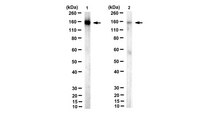MABE1073 Sigma-AldrichAnti-acetyl SMC3 Antibody (Lys105/106), clone 21A7
Anti-acetyl SMC3 (Lys105/106), clone 21A7, Cat. No. MABE1073, is a highly specific mouse monoclonal antibody that targets SMC3 Lys105/106 acetylation and has been tested in Chromatin Immunoprecipitation (ChIP), ChIP-seq, ELISA, and Western Blotting.
More>> Anti-acetyl SMC3 (Lys105/106), clone 21A7, Cat. No. MABE1073, is a highly specific mouse monoclonal antibody that targets SMC3 Lys105/106 acetylation and has been tested in Chromatin Immunoprecipitation (ChIP), ChIP-seq, ELISA, and Western Blotting. Less<<Produits recommandés
Aperçu
| Replacement Information |
|---|
Tableau de caractéristiques principal
| Species Reactivity | Key Applications | Host | Format | Antibody Type |
|---|---|---|---|---|
| H | ChIP, ChIP-seq, ELISA, WB | M | Purified | Monoclonal Antibody |
| References |
|---|
| Product Information | |
|---|---|
| Format | Purified |
| Presentation | Purified mouse IgG2b in buffer containing 0.1 M Tris-Glycine (pH 7.4), 150 mM NaCl with 0.05% sodium azide. |
| Quality Level | MQ100 |
| Physicochemical Information |
|---|
| Dimensions |
|---|
| Materials Information |
|---|
| Toxicological Information |
|---|
| Safety Information according to GHS |
|---|
| Safety Information |
|---|
| Storage and Shipping Information | |
|---|---|
| Storage Conditions | Stable for 1 year at 2-8°C from date of receipt. |
| Packaging Information | |
|---|---|
| Material Size | 100 µL |
| Transport Information |
|---|
| Supplemental Information |
|---|
| Specifications |
|---|
| Global Trade Item Number | |
|---|---|
| Référence | GTIN |
| MABE1073 | 04054839083686 |
Documentation
Anti-acetyl SMC3 Antibody (Lys105/106), clone 21A7 FDS
| Titre |
|---|







